Image: Work, Rest and Play: British Photography from the 1960s to Today, installation view, Beijing OCT-LOFT, Shenzhen, China
In this newly commissioned essay, Lucy Soutter offers a short history of the various key themes and approaches present within British photography of the last 50 years. The writing accompanies the international touring exhibition Work Rest and Play: British Photography from the 1960s to Today, curated by The Photographers’ Gallery, which tours through various locations in China during 2016.
Work, Rest and Play: British Photography from the 1960s to Today, installation view, Beijing OCT-LOFT, Shenzhen, China
***
In Work, Rest and Play we see a broad range of photographers turn their lenses on Britain and the British since the Second World War. The photographs range across various forms of British subject matter—people, places and things. Some of the images were made for an art context, some for commercial magazines, some as professional studio portraits and some to record events of social or political importance. Many of the photographs sit on the boundaries between these different categories, or occupy more than one at once. The images are distinctively British in a number of ways. In particular, they are dominated by a documentary approach that aims for objectivity while maintaining sensitivity to its subject matter. Even when they show poverty, social problems, vanity or vulgarity, they tend to do so with a certain warmth and even humour. The British have a centuries’ old tradition of self-criticism, satire and parody, grounded in a lively, argumentative popular press. Thus it is unsurprising that among these photographs we see a rich mix of attitudes, both celebratory and critical. The Britain they depict is an eclectic place where change is one of the only constants.
Work
The British class system was founded in work, and in the freedom from work available to the aristocratic land-owning class. By the 1950s, 60s and 70s, traditional class and labour roles were changing beyond recognition. Photographers could still capture places that had remained relatively unchanged for decades, such as Philip Jones Griffiths’ Welsh schoolboys, but many forms of class-based ritual and regalia were beginning to seem anachronistic or absurd. In his Only in England series of the 1960s, Tony Ray-Jones took on the role of social anthropologist to pinpoint particular foibles of the British. The most famous image in the series, Glyndebourne (1967) shows a wealthy couple eating a picnic in a cow field while attending an outdoor opera festival. Such contradictions create a visual essay about the shifting face of Britishness. In the 1970s, Patrick Ward pursued a similar project with Wish You Were Here: The English at Play. One of the strangest images shows an upper-class customer sitting astride an artificial horse whilst being fitted with bespoke jodhpurs. All three photographers were interested in the way that such fleeting details could help to capture the world around them as it changed.
Over the course of the 20th century, the industrial economy that had defined Britain at home and abroad was being dismantled piece by piece, creating social unrest as workers lost their jobs and unions lost their power. Photographers like Sirkka-Liisa Konttinen in the 1970s and Mark Neville in the 2010s, record working-class people in cities where the industrial work has gone. In its place, a new economy based on banking and information rose with the computer in the 1980s. Anna Fox provides a scathing portrait of the new forms of labour in her Work Stations series, depicting a culture of alienation, superficiality and excess. Other portrayals of contemporary labour are more approving. Evoking August Sander’s definitive typological series of German workers, Toby Glanville’s Actual Life series puts the workers front and centre, foregrounding their dignity, inviting us to reconsider the importance of traditional trades and crafts in the 21st century.
Leisure
The period spanned by this exhibition, from the 1950s to 2010s, witnessed a shift in leisure as well as work. As the nation’s economy gradually recovered after the war, individuals began to identify themselves less with their occupations and places of birth, and more in terms of their chosen hobbies, prized possessions, fashion choices and subcultures. These outlets allowed people to sidestep the social position into which they had been born, and to imagine themselves differently. Identity became partly a matter of choice and Britons participated enthusiastically in the choosing of theirs. After the war, Britain followed America in embracing youth culture, music and fashion. Photography did not merely record these trends, it helped to create them.
Fashion
In the 1960s, London designers, magazine editors and photographers set out to unseat Paris as capital of international fashion. New looks were accompanied by new ideas. By the mid-1960s, British Vogue, which had sold to an elite audience since the beginning of the 20th century, began to project a more edgy, youthful image. Nova, which ran from 1965-75, set out to be a radical, intellectual women’s magazine, with fashion spreads accompanied by articles on sex and politics. Terence Donovan’s fashion photography of the 1960s emphasised the daring new silhouettes and sometimes broke out of the photographer’s studio to show elegantly dressed models enjoying a playful freedom on the city streets. As Britain exported glamorous fictions like the James Bond films and the Avengers television series in the 1960s, London became the locus of international fantasies about a cosmopolitan lifestyle. This can be seen in the work of photographer James Barnor who moved to England from his native Ghana to produce striking cover images for the South African magazine Drum. Beautiful models of African heritage posed for Barnor in the latest cutting-edge jumpsuits and miniskirts against the backdrop of London locations. In reality, black Britons still encountered a great deal of prejudice, and black models had little exposure in home-grown magazines, but such images helped to make Drum a best-selling magazine in Africa and contributed to a global perception of London as a multicultural hub of style.
The Street
From the 1960s onwards, youth culture was increasing influenced by the street. Young people adapted styles to suit their own vision, and photographers avidly recorded the results. By the end of the 1970s, British street fashion had taken on a harder edge, with subcultural groups like punks, goths and skinheads adopting extreme looks in relation to their favoured music or politics. Derek Ridgers’ Night Club Portraits show young men and women whose do-it-yourself styles, drawing on influences as far ranging as 1920s Berlin cabaret performers, Japanese geishas and Native American warriors, set them apart from society in their own tribes. These fashions were deliberately incompatible with the expected uniform of any conventional job or role. Magazines like The Face and i-D (both founded in 1980) celebrated such extreme styles, with i-D regularly featuring “real people” describing how they had achieved their unique looks. Although the British are proud of certain aspects of conformity—being, for example, a law-abiding people happy to wait patiently in queues—at the same time, we have a high tolerance for the eccentric. The British love of fashion connects to this affinity for standing out from the crowd. Fashion also allows even the most straight-laced audiences to imagine other possibilities, other realities. In Tim Walker’s fashion fantasies we see beautiful models enacting fairy tale scenarios – the pleasurable escapism of the images often more important than the clothes themselves. Jason Evans’ influential “Strictly” fashion spread (first published in i-D in 1991 in collaboration with British stylist Simon Foxton) shows black models dressed as upper-class dandies, parading on real urban streets. The antithesis of the image of black youths as gangsters, these images create an alternate world into which viewers might choose to project themselves.
Celebrity
In the post-war period media attention shifted away from the activities of the aristocracy and onto the new heroes of the era of leisure: sportsmen, actors, musicians and models. Portrait photographers contributed to this trend by supplying striking images to appear in an ever-increasing number of newspapers and magazines. At its best, a celebrity portrait does not merely capture the appearance and personality of its sitter, but also conveys something of his or her importance within culture. Cecil Beaton, who had specialised in high society portraiture and fashion since the 1920s, applied all his skills of visual seduction to produce icons for the new age. His portrait of Mick Jagger makes the then-scandalously brash pop star look like an aesthete, a dandy and a poet. Although they were under-represented in the ranks of celebrity portraitists, female photographers made an outstanding contribution. Jane Bown’s long career spanned photojournalism as well as portraiture, including memorable images of many great British characters, from cockney actor and 60s sex-symbol Michael Caine to a whole range of highly influential women, including groundbreaking fashion designer Vivian Westwood, the first female prime minister, Margaret Thatcher and the greatest British icon of the 20th century, Queen Elizabeth II.
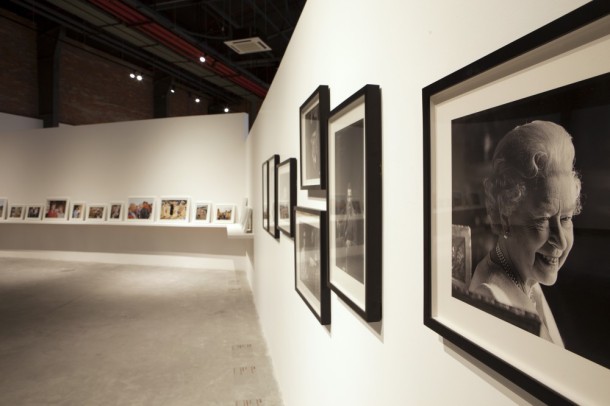
Work, Rest and Play: British Photography from the 1960s to Today, installation view, Beijing OCT-LOFT, Shenzhen, China
Using black and white long after colour became a viable option, Bown worked mostly with natural light to photograph faces with great psychological intensity. Seen primarily in popular newspapers such as the Observer, Bown’s pictures allowed ordinary people to feel like they really knew the celebrities depicted. Linda McCartney’s work pushed this sense of personal connection even further, with a more casual mode of portraiture that reflected the spirit of the 1970s. Married to Paul of music supergroup The Beatles, Linda McCartney was in a privileged position to produce images that were simultaneously family snapshots and celebrity portraits. This new intimacy had a great appeal for viewers, offering a sense of authenticity. The fascination with celebrities has continued to dominate the British media into the 21st century, pushing photographers to seek fresh, unexpected approaches. Spencer Murphy’s portraits combine formality and intimacy, offering us an opportunity to probe the faces of sportspeople, actors and authors who often seem absorbed in their own private thoughts.
Everyday People
Now displaced by the ubiquitous camera phone, high street photographic portrait studios once allowed anyone to imagine him or herself as a star. In his South London Brixton studio, Harry Jacobs catered to a clientele of first, second and third-generation Caribbean immigrants from the 1950s-90s. Photography was one of the ways that new Britons marked their assimilation into—and difference from—British culture at large. Although England welcomed an influx of workers from the Commonwealth to feed the growing economy of the 1960s, in practice white British communities did not always welcome the new arrivals. Although the techniques and poses Jacobs used mirrored those of every high street photographer in the land, the huge archive that he left after 40 years of work celebrates the changing ways that Britons of many races have presented themselves as the country has moved towards greater inclusiveness.
The Documentary Impulse
We could argue that the documentary impulse underlying so much British photography has its roots in the national character. As essayist George Orwell put it in 1941, “In England such concepts as justice, liberty and objective truth are still believed in.” In photographic terms, this has meant a preference for images that offer a sense of immediacy, simplicity and truth. The documentary approach is grounded in the grand projects of 19th century photography: recording and archiving the world as well as revealing social injustice.
These 19th century documents shared a visual style that appears as straightforward as possible, with no obvious staging or manipulation. Documentary photography has been so closely linked with the quest for truth, that viewers sometimes forget that each seemingly objective image is the product of a particular set of subjective decisions.
The development of documentary photography reflected the development of another realist form popular in Britain, the novel. And indeed, it may be helpful to think about British photography in relation to literary fiction. Like novels, documentary photographs may show us the lives of others while also teaching us about ourselves. They present a worldview that can be satisfyingly realistic, but is actually grounded in the sensibility of a particular individual. A photographer has an enormous number of choices not only in terms of his or her subject matter, but also in terms of point of view, distance, angle, lighting etc. The events and people shown may have actually existed in front of the camera, but the resulting documentary photographs reveal a selected version of reality, whether it is presented in a deadpan style or with a perceptible twist or transformation.
Expressive vs. Social Documentary
The photographers in this exhibition inflect documentary in a number of ways. Philip Jones Griffiths, best known as an incisive photographer of the Vietnam war, also made compassionate documents of the Britain that he saw changing around him. Shot from the 1950s onwards, his Recollections capture both everyday scenes and historic moments with empathy and tenderness. Some documentary projects have more pointed political intent. Finnish-born Sirkka-Liisa Konttinen worked as part of the photographic collective Amber, dedicated to documenting working class experience in the North of England. Her Byker series, begun in 1969, documents the human cost of urban redevelopment in Newcastle upon Tyne. Choosing to live among her subjects rather than view them from an external position, Konttinen captured vibrant moments in the lives of people ordinarily denied a place in public representation. The documentary photographs by Jamaican-born photographer Vanley Burke include both expressive street photography and politicized records of significant events. His series By the Rivers of Birmingham shows precious moments of pleasure, such as dodgem car racing at the fairground, as well as political struggles in the streets.
On the Edge of Satire
Photographs can walk a fine line between sincerity and irony. Very slight adjustments in the way an image is made or received can make it teeter between celebration and critique. Post-war British photographers have often enjoyed exploring this tension, mobilising photography as a medium for satire. Colour photography, with its exaggerated tones, provides a heightened visual vocabulary to explore the excesses of British culture. John Hinde Ltd. produced commercial photographic postcards of many of Britain’s most beloved working-class holiday spots, from the garish splendour of Butlins holiday camps to a sprawl of seaside caravans. Hinde intended these images to celebrate British leisure and beauty spots. Yet when they were first produced in the 1960s, such images were shockingly bright in relation to the familiar black and white picture postcards. Both then and now, some viewers would look at these images with pleasurable nostalgia for the places depicted, others with horror at their kitsch vulgarity, while still others would enjoy feeling both these emotions at once.
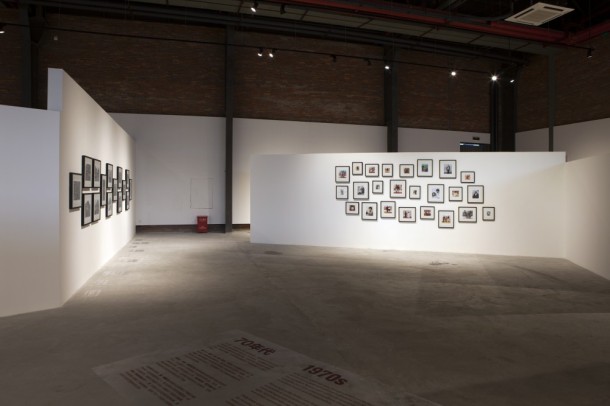
Work, Rest and Play: British Photography from the 1960s to Today, installation view, Beijing OCT-LOFT, Shenzhen, China
Photographer Martin Parr has been the most prominent photographer to mobilise this kind of mixed response for art purposes. Following in the footsteps of Tony Ray-Jones and Patrick Ward, Parr sets out to capture the characteristics of the current age. Working in colour from the early 1980s, Parr has turned an affectionate yet satirical eye on Britons’ everyday behaviour, from the gluttony of seaside hotdog eaters to the vanity and exhibitionism of girls with hats the size of cartwheels at the Ascot Horse Races. John Tonks pursues a related project, though with a slightly more muted tone, in his case exploring how Britishness may still be perceived in the farthest reaches of the colonies, the remaining British territories in the South Atlantic. His Empire series, begun in 2007, locates Union Jack flags in the most unlikely of places and provides a wistful view of the customs and aspects of British material culture that appear very out-of-place in their distant contexts.
Avoiding Exploitation
A central question for documentary photographers is how to avoid exploiting the people they depict. Photographers have addressed this by focusing on their own community (Burke), embedding themselves within a community (Konttinen) or by exaggerating their own position to make a point (Parr). Nigel Shafran avoided depicting people at all, in a series of luminous still life images entitled Supermarket Checkouts. These improvised arrangements are in some senses object portraits of the customers who made them. Mark Neville came up with another ingenious solution to the issue when he completed a 2004 residency photographing the community of the former ship-building town Port Glasgow, Scotland. Eight thousand copies of the book Neville created to document the community were delivered by hand to the eight thousand families who lived there, and no further copies of the publication were made available to anyone. As well as questioning the way that photographic documents are usually circulated to an outside audience, this allows the pictures to “belong” more fully to the people depicted in them.
The Conceptual Turn
From the 1970s onwards, the documentary impulse in British photography has taken a conceptual turn, partly in relation to developments in contemporary art, and partly as a result of the way photography has been taught within universities. Until the 1980s, if photography was taught in universities at all, it was regarded as a technical rather than artistic specialism. However, from the 1970s new ideas in photographic education and new movements that included post-structuralist, feminist and psychoanalytic theory, led many conceptual artists to turn to photography because it seemed free from the academic baggage of painting and sculpture. For this generation of artists, photography supplied an image that could be combined with text to produce a new kind of art, intellectually and politically engaged. A key task of this kind of work was to challenge photographic representation itself. One of the results of this project has been that photography now rivals—if not surpasses—painting and sculpture as an ambitious contemporary art form.
Paul Seawright brought a conceptual approach to bear in his Sectarian Murders series, made in the 1970s. Colour images, made to place the viewer right at the heart of the scene, document the banal locations where various murders occurred during “The Troubles” – the conflict in Northern Ireland often defined along religious grounds between Protestants and Catholics. Seawright captioned the images with newspaper reports of the deaths, but removed all reference to the religions of the victims, all of whom had been murdered for their perceived religious affiliation. In making the deaths generic, Seawright focuses on the cruel, arbitrary nature of the conflict, and challenges the role of news photography and newspaper copy in the production of history and memory. Karen Knorr also brought image and text together with political intent in her Gentlemen series (1981-83), shot in London’s most exclusive, elitist all-male clubs. Made during the Falklands war, at a time when Margaret Thatcher’s Conservative policies were in the ascendant, the project uses a number of different kinds of text to explore the class and gender relations that seemed hardly to have changed since such clubs were first founded in the 18th century. Conceptual and political, Knorr’s photographic work is also strikingly pictorial, with view camera images carefully composed according to compositional principles drawn from painting, and the interiors and furnishings of the clubs evoking classical art history.
A New Pictorialism
A combination of lush visuality and conceptual content has run through the majority of British art photography made since the 1980s. This approach has been reinforced by the fact that many of the most influential photographers (including Seawright and Knorr) have also had careers as influential educators. Most works are produced in series, guided by a single rationale. In the 1990s, the relationship between image and concept sometimes became more oblique or poetic. Like Seawright, Tom Hunter has revisited the sites of news stories, but in his case local London headlines are restaged with reference to the compositions of Old Master paintings. Thus a woman reading her eviction notice plays on a painting by Johannes Vermeer, and a girl drowned in a Hackney canal evokes Sir John Everett Millais’ Pre-Raphaelite painting Ophelia. Although the work is still political, with its focus on the experience of working-class people, this connection to art history earned Hunter the first retrospective exhibition of photography at the National Gallery, London, in 2006.
Like Hunter, Simon Roberts also makes large-scale pictures with the physical presence of paintings. His 2007-08 series We English returns to the subject matter of Tony Ray-Jones and Patrick Ward—the English at leisure—but places them within a larger frame. Roberts’ large-format view camera includes all the details of people and their quirky activities, and sets them within the broader sweep of the British countryside. His pictorial approach allows the photographs to be sociological studies and grand landscapes at the same time. Similarly, many contemporary British photographs provide a twist on the traditional genres of landscape, portraiture, still life and history painting, drawing links between photography and a broader history of art. Over the course of the 1990s and 2000s, the number of gallery and museum exhibitions of photography increased rapidly, the market for photographs has expanded exponentially and photography has become an increasing popular subject for university study.
Artistic Research
In recent years, many British art photographers have approached their work with various kinds of research. Additional texts in the form of titles, wall text, soundtracks, artists’ statements, press releases or catalogue essays often circulate around the images, providing a discursive context to deepen their meaning. Claire Strand’s Gone Astray series includes studio portraits of residents of Clerkenwell (the part of London where Charles Dickens set his novel Oliver Twist), accompanied by fragments of narrative written by the artist. The result was a kind of personal diary as well as a product of historical and cultural research into the area. Dryden Goodwin’s Caul series combines street photography with drawing. Photographs of passengers on London public transport are traced over with an agitated red line that evokes the restless movement of the eye across the surface of an object. Part of a larger exploration of the relationship between photography and drawing, these are meditations on the way we look at strangers. Sometimes photographic research is less analytical and more intuitive. Stephen Gill’s Talking to Ants (2009-15) involved the photographer placing insects and objects into the body of his camera to produce unique layered images that evoke dream states or an “ant’s eye-view” of his East London neighbourhood. Such images show that contemporary artistic research can also be personal and poetic.
Video
Emerging with the first portable video cameras in the early 1970s, video art has always been defined in part by what it is not: not television, not cinema and not still photography. Photographic artists sometimes turn to video when a sense of duration can add a crucial impact to their work. Gillian Wearing has worked both with still and moving image, inviting members of the public to expose themselves in surprising ways. Wearing has invited strangers to tell secrets, make confessions, or in the case of Sixty Minute Silence, attempt to sit completely still for an entire hour. Playing on the long exposure times of 19th century photographic portraiture, this piece is also amusing with a twist of cruelty; there is something pleasurable in seeing a large group of police officers forced to sit still. Their inevitable restlessness gives the piece a building sense of tension.
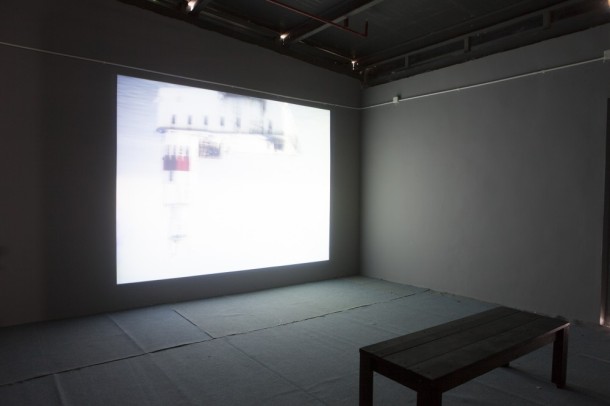
Work, Rest and Play: British Photography from the 1960s to Today, installation view, Beijing OCT-LOFT, Shenzhen, China

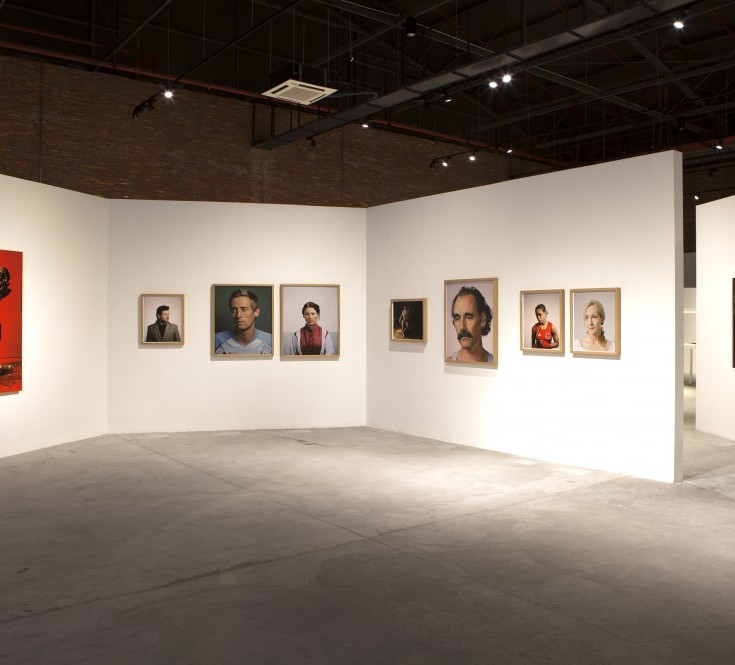
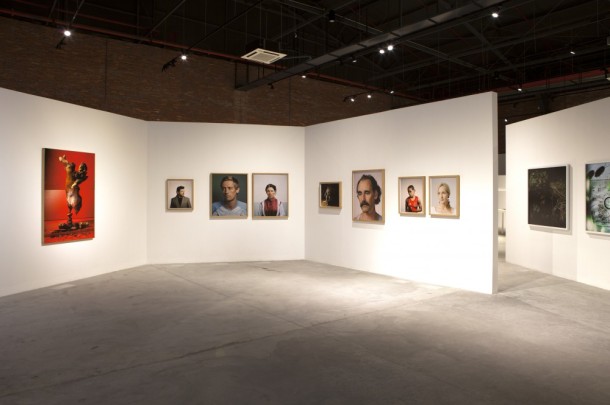
Interesting